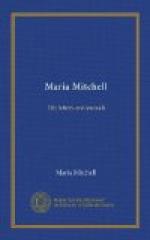In August, 1869, Miss Mitchell, with several of her Vassar students, went to Burlington, Ia., to observe the total eclipse of the sun. She wrote a popular account of her observations, which was printed in “Hours at Home” for September, 1869. Her records were published in Professor Coffin’s report, as she was a member of his party.
“Sept. 26, 1871. My classes came in to-day for the first time; twenty-five students—more than ever before; fine, splendid-looking girls. I felt almost frightened at the responsibility which came into my hands—of the possible twist which I might give them.
“1871. I never look upon the mass of girls going into our dining-room or chapel without feeling their nobility, the sovereignty of their pure spirit.”
The following letter from Miss Mitchell, though written at a later date, gives an idea of the practical observing done by her classes:
MY DEAR MISS ——: I reply to your questions concerning the observatory which you propose to establish. And, first, let me congratulate you that you begin small. A large telescope is a great luxury, but it is an enormous expense, and not at all necessary for teaching.... My beginning class uses only a small portable equatorial. It stands out-doors from 7 A.M. to 9 P.M. The girls are encouraged to use it: they are expected to determine the rotation of the sun on its axis by watching the spots—the same for the planet Jupiter; they determine the revolution of Titan by watching its motions, the retrograde and direct motion of the planets among the stars, the position of the sun with reference to its setting in winter and summer, the phases of Venus. All their book learning in astronomy should be mathematical. The astronomy which is not mathematical is what is so ludicrously called “Geography of the Heavens”—is not astronomy at all.
My senior class, generally small, say six, is received as a class, but in practical astronomy each girl is taught separately. I believe in small classes. I instruct them separately, first in the use of the meridian instrument, and next in that of the equatorial. They obtain the time for the college by meridian passage of stars; they use the equatorial just as far as they can do with very insufficient mechanism. We work wholly on planets, and they are taught to find a planet at any hour of the day, to make drawings of what they see, and to determine positions of planets and satellites. With the clock and chronograph they determine difference of right ascension of objects by the electric mode of recording. They make, sometimes, very accurate drawings, and they learn to know the satellites of Saturn (Titan, Rhea, etc.) by their different physiognomy, as they would persons. They have sometimes measured diameters.
If you add to your observatory a meridian instrument, I should advise a small one. Size




